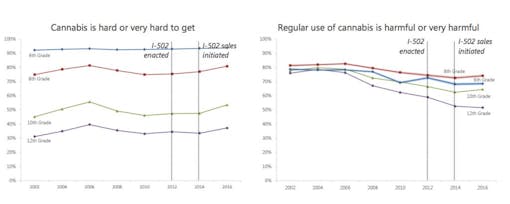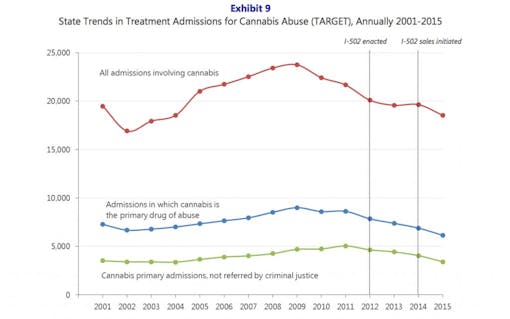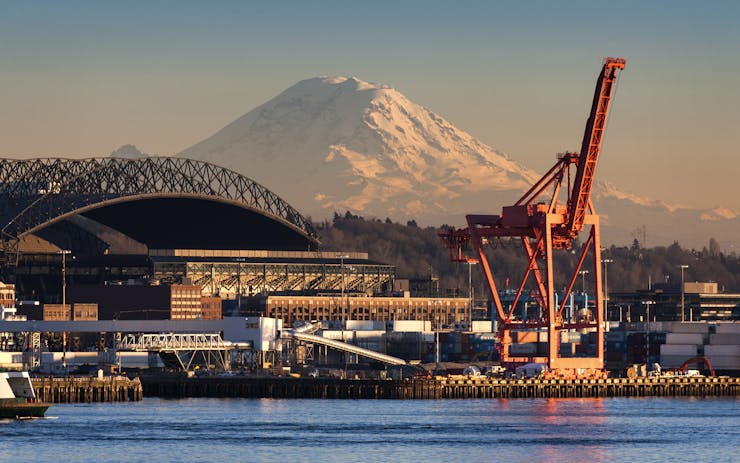For legalization opponents eager to see regulated cannabis markets fail, a new government report out of Washington state isn’t yielding much in the way of talking points.
Since 2012, when the state became one of the first in the country to legalize cannabis for adult use, consumption rates among minors have remained stable or fallen. The number of admissions to treatment for cannabis use disorder—and in fact, all admissions involving cannabis—have gently declined. There’s even some evidence that legalization in the Pacific Northwest “may have led to a drop in rape and murder rates,” the report says.
The findings were published this month by the government-run Washington State Institute for Public Policy (WSIPP), which is required under the state’s legalization law, Initiative 502, to conduct regular cost-benefit analyses for the next 25 years. The report’s conclusions are still preliminary, but the emerging picture is one of a relatively healthy cannabis program free of the horrors forecasted by critics.
“In my overall appraisal, there’s not much evidence I-502 has caused changes in the outcomes we looked at,” the report’s lead researcher and author, Adam Darnell, told the Seattle Times.
Some of the most reassuring findings have to do with children. Prohibitionists have long warned that legalization would increase cannabis consumption by minors, but in Washington, the numbers tell a different story. Among students, cannabis use rates have steadily fallen since 2012, when voters adopted adult-use legalization. Rates began dropping even more sharply in 2014, when regulated sales began.

Prohibitionists said legalization would lead to higher rates of use by minors. The opposite seems to be happening. (Washington State Institute for Public Policy)
Since legalization, more teens are reporting that cannabis is “hard or very hard to get,” the report found, refuting legalization critics’ fears that legal sales mean easier access for minors.
Critics have also worried that legalization could send kids the message that cannabis use is healthy, but the report indicates the opposite is happening. Students’ perception that cannabis is “harmful or very harmful”—which had been in decline since 2006—actually increased among most students since legal sales began. “The downward trend in perceived harm of cannabis use stabilized from 2014 to 2016,” the report found.

More students say cannabis is “hard or very hard to get” today than before legalization, and concern over the health effects of cannabis are stabilizing. (Washington State Institute for Public Policy)
While cannabis use has fallen among minors since legalization, it’s risen slightly among adults. Use rates climbed noticeably during the first several months following the launch of adult-use sales—perhaps because of the novelty of newly legal cannabis—but have since mostly subsided.

Cannabis consumption rose noticeably after legal markets opened, but the increase has since mostly subsided. (Washington State Institute for Public Policy)
Notably, however, those increases haven’t led to more drug-treatment admissions. “We found that cannabis abuse treatment admissions were not affected by I-502 enactment,” the report’s authors write. “We also found that the amount of legal cannabis sales generally had no effect on outcomes.”
Shop highly rated dispensaries near you
Showing you dispensaries nearWhile a drop in court-referred treatment admissions might be no surprise—the number of cannabis-related criminal convictions has fallen since legalization—there was also a notable decline in admissions that weren’t referred by the criminal justice system. While the report notes that “there is no evidence that the enactment of I-502 caused this change,” the findings nevertheless go against prohibitionists’ predictions that treatment admissions would skyrocket as a consequence of legalization.

Admissions to treatment for cannabis and other drug disorders have actually fallen since legalization. (Washington State Institute for Public Policy)
Legalization’s effects on violent crime aren’t yet fully clear, but the report does highlight a pair of studies indicating legalization may helped tamp down violence. One study, relying on FBI-reported crimes, found evidence “of decreased homicide and assault associated with medical legalization.” Another, looking at adult use, “found evidence that non-medical legalization in Washington and Oregon may have led to a drop in rape and murder rates.”
In digesting the report’s findings, it’s crucial to keep in mind that legalization is largely uncharted territory. Washington’s legalization law “imposed a number of different changes on the state,” the report says, “including changes to criminal prohibitions; the creation of a regulated cannabis supply system; and mandated investments in substance abuse prevention, treatment, and research. Each aspect of I-502 may have had its own effects on outcomes.”
Nevertheless, the important takeaway is this: The parade of horribles predicted by opponents of cannabis legalization simply hasn’t happened. Since Washington state became one of the first to challenge federal prohibition, residents here have largely kept calm and carried on.





